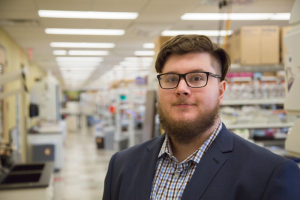Nathaniel Piety, a biomedical engineering doctoral student at the UH Cullen College of Engineering, was recently awarded an American Heart Association (AHA) Predoctoral Fellowship. The two-year, $52,000 award is for the development of a paper-based test aimed at preventing stroke in individuals with sickle cell disease receiving chronic blood transfusions.
Sickle cell disease is an inherited hemoglobin disorder that causes numerous red blood cell structural and functional abnormalities which result in a host of systemic injuries, one of the most serious of which is stroke. Many individuals with sickle cell disease require chronic blood transfusions every few months to reduce the level of sickle hemoglobin in their blood and thus alleviate the risk of stroke associated with the disease.
Existing blood transfusion technology does not provide doctors with access to precise, real-time levels of sickle hemoglobin in patients during and between transfusions. If sickle hemoglobin is not monitored during transfusion, individuals with sickle cell disease are at risk for stroke if too little blood is transfused or adverse side effects, such as alloimmunization or iron overload, if too much is transfused.
With this test, Piety and his faculty advisor, biomedical engineering associate professor Sergey Shevkoplyas, aim to provide a low cost and highly precise technology that allows health professionals to monitor patients’ sickle hemoglobin in real time during transfusion.
The paper-based test works by combining a drop of the patient’s blood with chemicals that release hemoglobin from red blood cells and cause sickle hemoglobin to clump together. When the mixture of blood and chemicals is dropped on paper, normal hemoglobin wicks outwards through the paper, while clumps of sickle hemoglobin are trapped by the paper fibers. The resulting pattern can be used to quantify the level of sickle hemoglobin in the patient’s blood.
This project began several years ago during Piety’s undergraduate studies at Tulane University where he first met Shevkoplyas and began researching blood microfluidics and blood storage for transfusions. Because sickle cell disease patients often require chronic transfusions, they represent a population that could uniquely benefit from their research.
“Historically, sickle cell disease was somewhat neglected and only recently have researchers started exploring it more deeply. Because of this, there’s a lot of room for innovation,” Piety said.
Now in his third year at the Cullen College, Piety is looking forward to the opportunity to further improve the speed and accuracy of the test with the support of the AHA fellowship.
Piety said that collaborations within the Texas Medical Center have proven vital to ensuring the test’s clinical viability. Piety and Shevkoplyas are working closely with Alex George, co-director of the Sickle Cell Program at Texas Children’s Hospital. George provides Piety with insights into the standards of care for patients, the clinical perspective on current technologies and ongoing feedback as to how the test can be improved.
“[Dr. Shevkoplyas and I] want to do research that has immediate, real world implications and impact. And with this project, in particular, we really think we can do something that matters,” Piety said.
